Mantra Śāstra: A Few Principles for Remedies from Rāvaṇa’s Uḍḍiśa Tantra
Gati: The Direction of the Mind (Moon)
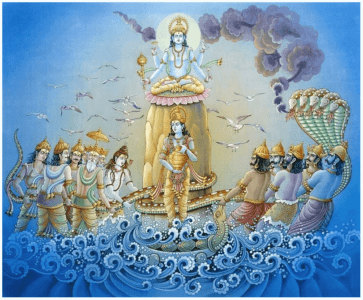
Once upon a time, many eons ago, at the time when Śrī had left the gods, Śiva blessed the High Priest of the dark side, Śukrācārya, with the unequivocal Mṛta Sañjīvanī knowledge, by which the asuras (demons) came back to life from the dead, irrevocably more powerful and supreme as conquistadors. Shaken by this turn of events, the gods approached Lord Viṣṇu, who assuming the form of a unique tortoise[2] assisted the devas (gods) in churning[3] the Milky Ocean[4] whereby Amṛta, the Nectar of Immortality could be extracted. In this epochal exercise, Viṣṇu used the magnificent Mandār Mountain as the churning rod and the Divine Serpent, the multi-headed great Vāsuki, as the churning rope.
Viṣṇu arrived on the shores of the Milky Ocean with Garuḍa, having hauled Mandār on the way, like a puny toy. Upon arrival, he bade farewell to Garuḍa and send him off, for Vāsuki would not emerge even by mistake, as long as Garuḍa was present. In his supreme wisdom, Viṣṇu knew, even the Divine Serpent Śeśa Nāga would tremble in the presence of the greatest eater of snakes. Garuḍa is a bird, admittedly a divine bird, and so represented by the Sun, while Rāhu represents snakes. Though the latter has the power to eclipse the former, the Sun is the one who exposes Rāhu. Mantras of Garuḍa are therefore the supreme remedy for sarpa doṣa or those troubled by serpents of all kinds. The simple mantra for warding of serpentine evils, om pakṣī svāhā is chanted in reverese as kṣipa om svāhā, prempting Rāhu’s misdeeds of reversal. For whilst chanting a mantra for cutting the bondage of snakes, Rāhu would do his utmost to reverse the process. Kṣipa om svāhā would thus automatically become om pakṣī svāhā[5].
Both the devas and the asuras participated in the churning of the Kśīrasamudra, and after the preliminaries were complete, Viṣṇu proceeded towards the head of Vāsuki, followed by the other gods. The asuras, slighted at the thought that they had to occupy the lowly tail of the Great Snake, ranted that the reputation of their birth and karma, prevented them from occupying such an “inauspicious” position as the tail of a snake during the grand event of the churning of the ocean. Viṣṇu smiled and without hesitation headed towards the tail of Vāsuki with the devas. For he knew, that it was natural for the asuras to opt for the snake’s head as it represented material enjoyment and abhorr the thought of sitting near the tail, which led to the spiritual path and eventually towards emancipation.
The head of the snake was thus occupied by the asuras while the devatās sat on the tail. Astrologically depicted, the head of the snake is Rāhu and the tail is Ketu. Jupiter, Sun and Ketu are posited on the tail, on the mokṣa mārga (path of renunciation) while Saturn, Mars and Rāhu are stationed at the head, on the bhoga mārga (path of material enjoyment). The Moon is stationed at the centre of the snake, perfectly poised. It depends on the direction of the mind, as to whether the Moon will veer towards Rāhu or Ketu, that is, is the mind moving towards a material or a more spiritual path.
 The churning of the ocean initially released a terrible poison, Kālakūṭa, which was subsequently consumed by Śiva[6]. The act of churning affects the indriyas (senses) through this poison and the indriyas in turn, have an impact on the mind. The different grahas aspecting the Moon thus influence the mind through the indriyas. Once the mind is affected it becomes biased and it is no more in perfect balance. It therefore calls for protection, and this protection is provided by mantras. The ultimate aim of mantras is to detach the mind from the indriyas and make it move towards Om. For Om is the one thought, and one vibration, the singular truth towards which the mind should be focussed. This is the perfect mantra, the pure sātvik chant that makes one seek out that unique vibration that is the source of all reality.
The churning of the ocean initially released a terrible poison, Kālakūṭa, which was subsequently consumed by Śiva[6]. The act of churning affects the indriyas (senses) through this poison and the indriyas in turn, have an impact on the mind. The different grahas aspecting the Moon thus influence the mind through the indriyas. Once the mind is affected it becomes biased and it is no more in perfect balance. It therefore calls for protection, and this protection is provided by mantras. The ultimate aim of mantras is to detach the mind from the indriyas and make it move towards Om. For Om is the one thought, and one vibration, the singular truth towards which the mind should be focussed. This is the perfect mantra, the pure sātvik chant that makes one seek out that unique vibration that is the source of all reality.
Mantras which operate at the level of the indriyas, deal with the material plane and are of three types. They are rājasik by nature and can even be tāmasik depending upon the nature of the mantra and the purpose of use. The mantras will work through the ārūḍhas as the mana works through the ārūḍhas.
Table 1: Basic Structuring

Chhanda[7]: The Rhythm of Everyday Work (Sun)
 The Sun, resplendent and glorious in his twelve forms, as the ruler of the day and the lord of the grahas, is the controller of Time. The different kāla sankhyās or the measurements of time like kṣaṇ, muhūrta, divasa, rātri, pakṣa, māsa, saṁvatsara, ṛtu, ayana and yugas are the different parts of his amazing one-wheeled chariot. Without Āditya, there can be no dimension of time and no order in the universe. The Sun’s basic measurement of time on earth is from sunrise to sunrise, as it traverses the complete round of the twelve rāśis, demarcating the period into day and night, aho and rātri.
The Sun, resplendent and glorious in his twelve forms, as the ruler of the day and the lord of the grahas, is the controller of Time. The different kāla sankhyās or the measurements of time like kṣaṇ, muhūrta, divasa, rātri, pakṣa, māsa, saṁvatsara, ṛtu, ayana and yugas are the different parts of his amazing one-wheeled chariot. Without Āditya, there can be no dimension of time and no order in the universe. The Sun’s basic measurement of time on earth is from sunrise to sunrise, as it traverses the complete round of the twelve rāśis, demarcating the period into day and night, aho and rātri.
The Sun executes the entire material work of the universe in seven chhandas, which are directly connected to the seven days (vāra) of the week and the hours (horā and kāla) of the day. The chhandas in the form of seven horses pull the Sun’s chariot through its course in the skies, across day and night, the twelve months, the summer and the winter solstices. These seven chhandas are gāyatrī, triṣṭup, jagatī, anuṣṭup, paṁkti, bṛhatī and uṣñik.
Material creations are associated with rasas (flavour) as everything is defined in terms of the seven rasas. The seven rasas and chhandas correspond with each other as each chhanda activates a rasa within us. For example, the gāyatrī chhanda activates the sweet or madhur rasa. Mantras are set to the rhythm of these chhandas, which resonate to a certain vibration within the chanter.
Ṣaṭkarma[8]
The sixth house of the zodiac is replete with negative connotations both within and without the native, of diseases, enemies, conflicts, litigation, battles, injuries and the ṣaḍripu[9] or the six flaws of man, which are the internal enemies by which the mind is increasingly attached to the indriyas. One can control and eventually eradicate these ripus or internal enemies by changing the guṇa of the mind through mantras. Similarly, the evils of the sixth house can be mitigated and sometimes conquered through remedial intervention.
 Daśānana or the ten headed demon king Rāvaṇa, in his magnum opus, Rāvaṇa Saṁhitā, (which is a veritable treasure of astrological nuggets and secrets of mantra śāstra), wrote the Uḍḍīśa Tantra, a unique book on remedies. Rāvaṇa’s tremendous knowledge and his devotion to Lord Śiva are legendary, and it is by appeasing the Trident-holder that he acquired his brilliant knowledge of the mantras. Prior to embarking upon his battle with Śrī Rāma, Rāvaṇa prayed intensely to Śiva and the great lord himself imparted this special knowledge of mantra śāstra to Rāvaṇa in his own words, which he in turn, penned under the title of Uḍḍīśa Tantra. The Uḍḍīśa hinges on the principle of the five elements or the pañca tatvas, hinting that when there is a tatva imbalance in the horoscope it may be rectified by the correct remedial measure.
Daśānana or the ten headed demon king Rāvaṇa, in his magnum opus, Rāvaṇa Saṁhitā, (which is a veritable treasure of astrological nuggets and secrets of mantra śāstra), wrote the Uḍḍīśa Tantra, a unique book on remedies. Rāvaṇa’s tremendous knowledge and his devotion to Lord Śiva are legendary, and it is by appeasing the Trident-holder that he acquired his brilliant knowledge of the mantras. Prior to embarking upon his battle with Śrī Rāma, Rāvaṇa prayed intensely to Śiva and the great lord himself imparted this special knowledge of mantra śāstra to Rāvaṇa in his own words, which he in turn, penned under the title of Uḍḍīśa Tantra. The Uḍḍīśa hinges on the principle of the five elements or the pañca tatvas, hinting that when there is a tatva imbalance in the horoscope it may be rectified by the correct remedial measure.
Śiva begins his discourse to Rāvaṇa by classifying mantras into six categories, which he calls the ṣaṭkarma or the six kinds of action.
Table 2: Shatkarma

Śānti is the best and the only sātvik karma and should be performed at all times and for all purposes. It can pacify malefic planets (krūra graha doṣas), remove disease, restore health and give hope and peace to the dejected and depressed. Vaśīkaraṇa includes the entire gamut of mohana mantras, used to attract another person, especially those of the opposite sex. It is not recommended that these methods be resorted to ensnare another human being as it is not based on true emotions between two people and may wean off after the effect of mantra wears out. Stambhana is the power to freeze someone into inaction and can stun a person’s speech or any of his bodily functions. Vidveṣaṇa creates rifts and enmity between people, often among couples, business partners, family members and friends. The next two karmas are tāmasik in nature. Ucchāṭana are extremely tāmasik mantras and can harm a person seriously by expelling him (ejection) from his home, office, or country. Māraṇa is the worst karma any human being can perform, that is killing or robbing someone of his life including a trail of destruction.
While reading the Uḍḍīśa, it must be kept in mind, that Rāvaṇa received this knowledge immediately before he waged his final war with Rāma. He had received it as an answer to his request of learning techniques for this specific purpose, i.e. to destroy the huge Vānara Senā or the Monkey Troops, who had amassed in hordes across the waters of the Indian Ocean, led by the King of Ayodhyā himself, the great Śrī Rāmachandra and his brother Lakṣmaṇa. It then becomes clear as to why there are mantras for death and destruction, of parting the waters, of flaming houses, of creating enmity and separation between people, of mohana or attraction mantras, which were probably used to deploy women spies in the enemy camp.

This is a tantra designed specifically for the purposes of war and it is apparent that these war-designed principles spilled over in the later days to form the substance of tantra based mantra śāstra and incorporated into the daily lives of people. Hence rājasik and tāmasik mantras designed for war and politics, came into vogue for common usage. Such mantras are prescribed ad lib by many astrologers in the modern era as remedial measures. Nevertheless, it conceals some high principles of mantra śāstra and it would be our task to glean it out as the swan weans the milk from the water.
Table 3: The Deities of Shatkarma

Table 3 details the deities, direction, time, season, day, nakṣatras, tithis and lagnas appropriate for carrying out these ṣaṭkarmas. This seems to follow a predictable pattern. Riktā tithis like amāvasyā and kṛṣṇa caturdaśī, directions like Naiṛṛtti (the inauspicious southwest ruled by Rāhu) and Vāyu (the west ruled by Saturn), days like Saturdays and Tuesdays and the predominance of malefic planets are suggested while performing tāmasik karmas. Sātvik and more benign karmas are suited for Thursdays, Wednesdays and Mondays, tithis like pūrṇimā, pañcamī and tṛtīyā, and directions like the Īśāna, which is ruled by Jupiter and is the best for knowledge, spirituality and blessings. The interesting lesson here is on the suggestions about time. The six seasons are mapped onto the day starting at local sunrise, with each season being allocated four hours each. This has been worked out in Table 3 using a default sunrise time of 6 a.m.
Bījas in ṣaṭkarma
Table 4: Tattvas and Shatkarma

The Uḍḍīśa provides corresponding bījas, āsanas and mudrās to the ṣaṭkarmas. Bījas such as namah and svāhā are used for śānti karma and sātvik mantras and remedial measures, while huṁ, the damana or suppression bīja, is used for removing evils, dangers and for tāmasik activities. Mantras are classified as masculine, feminine and neuter as well; with feminine mantras having a svāhā ending, neuter mantras have a namah ending while masculine mantras end with huṁ phaṭ. Āgneya (fiery, hot) mantras end with oṁ. Mantras, which have the chandrabindu, are saumya (cool, peaceful) mantras. If a saumya mantra has a phaṭ in the end, it becomes an āgneya mantra, and if an āgneya mantra has a namah in the end, it becomes a saumya mantra. The form of the deity to be worshipped, their colour, posture and appearance are vividly described in the Uḍḍīśa for each of the karmas to be prescribed.
Tattvas in Mantras
Table 5: Tattvas and Worship in the Paramparā

 Tattvas are crucial for worship and remedial measures. The ṣaṭkarma in the Uḍḍīśa are associated with the five elements of water, earth, fire, wind and ether. Such karmas are performed when the corresponding tattva is rising. Tattvas are of a span of 6 minutes each and there are 240 tattvas in a day. Each day has 8 yamas of 3 hours each. Each yama is divided in two kāla of one and a half hours. Hence, in a day there are 16 kalas. Each kāla is divided into 15 tattvas each having a span of 6 minutes. From sunrise to sunset, there are 120 tattvas and from sunset to sunrise, there are another 120 tattvas. The tattvas are mapped starting from the lord of the day in the order of jala, agni, pṛthivī, vāyu, ākāśa. Therefore, for a Monday, the starting tattva would be jala, as the lord of the day is a jala tattva planet. The second set of 15 tattvas start in reverse.
Tattvas are crucial for worship and remedial measures. The ṣaṭkarma in the Uḍḍīśa are associated with the five elements of water, earth, fire, wind and ether. Such karmas are performed when the corresponding tattva is rising. Tattvas are of a span of 6 minutes each and there are 240 tattvas in a day. Each day has 8 yamas of 3 hours each. Each yama is divided in two kāla of one and a half hours. Hence, in a day there are 16 kalas. Each kāla is divided into 15 tattvas each having a span of 6 minutes. From sunrise to sunset, there are 120 tattvas and from sunset to sunrise, there are another 120 tattvas. The tattvas are mapped starting from the lord of the day in the order of jala, agni, pṛthivī, vāyu, ākāśa. Therefore, for a Monday, the starting tattva would be jala, as the lord of the day is a jala tattva planet. The second set of 15 tattvas start in reverse.
However, the paramparā and most traditions in India, teach a different set of bījas corresponding with the five tattvas, and the necessary remedial karma attached with them. The five planets with physical bodies, with the exception of the nodes and luminaries, are associated with these five elements. When any of these tattvas are afflicted in a chart, mantras with the appropriate bījas are to be chanted and remedial measures that incorporate the karma associated with the afflicted tattva should be performed. For example, if agni tattva is afflicted in a horoscope, then the native should be advised to light a lamp, above other worship rituals. Those who have an afflicted jala tattva should utilise water in worship rituals. Bowls of pure, clean water, sweetly perfumed and laced with sandalwood and camphor may be kept in the alter. It would help to remove the blemishes on many a jala tattva planet in a chart. Mantras can also be chanted putting one’s hand over vessels of water and then drinking it.
Lighting of the lamp per se, is an important ritual for any worship and remedial measure. The oil in the lamp is the body and hence is a crucial indicator for remedies pertaining to health issues. The wick is the ātmā. If the wick burns completely it shows that the native has completed his karma, if half of the wick remains, it shows that some karma is to be completed. The fire is the longevity. Offering flowers to the deity, can remove vidveṣaṇa, as when the ākāśa tattva is vitiated, enmity between people arise.
Digbala and Tattvas
There are two kinds of digbala; one from the lagna and the other from the ārūḍha lagna. The lagna shows physical direction while the ārūḍha lagna shows the ayana or the goal of life. The planets getting digbala will indicate a strong ayana. The tattvas are used for remedial measures to achieve these ayanas and to rectify it when it is weak and afflicted. The ayanas are mapped into the four kendras:
Table 6: Dig and Ayana Bala

The two planets, which get digbala in the lagna, are Jupiter and Mercury. The lagna represents the dharma ayana. Dharma is at a dual level. One is at the level of the material/physical world based on the pṛthivī tattva of Mercury. This is governed by Gaṇeśa. The other is the sanātana dharma of the world ruled by sarvavyāpakeśwara Viṣṇu and hence indicated by Jupiter (Ākāśa), and in this form he is Nārāyaṇa. Hence, Gaṇapati and Nārāyaṇa are the two protectors of dharma. The dharma of the lagna is the ayana of man, which is Nara (man) + Ayana (goal). Sun and Mars get digbala in the 10th house, which is associated with agni tattva. The tenth house, which is the throne of the horoscope, is concerned with work and income, wealth and success. This is to do with artha śāstra, which is concerned with the land and the world. The work performed is converted to energy and money. Problems in this area can be rectified by balancing the Agni tattva and making it positive. A strong and positive Agni produces a fabulous worker. Both Śūrya and Śiva can be worshipped to strengthen the Agni tattva and for purposes of work.


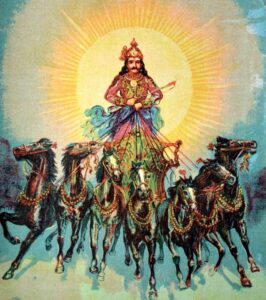

Saturn gets digbala in the seventh house and is to do with the kāma ayana, which is to do with relationships, and desires in general. Saturn rules vāyu tattva, and in the case it is afflicted, worshipping Śiva and doing karma associated with vāyu tattva like burning many incense sticks, lighting a mustard oil rather than a ghee lamp, are recommended remedial measures. Moon and Venus gets digbala in the fourth house of mokṣa ayana, the abode of jala and the domain of sātvik karma. This is relevant for one’s spiritual life and śānti karma.
Example
Chart 1: Agni Affliction


This example is a severe case of Agni tattva affliction. The native has Scorpio rising and an exchange between Sun and Mars, the lagna and the 10th lords. Both the houses have signs and lords, which are Agni tattva. Sun is strongly afflicted, not only by this exchange, but also by the aspects of Mars, Saturn and Rāhu. This affliction is so intense, that the Agni tattva is not only imbalanced but vitiated so that the potential of a Sun in a lagna or a tenth lord in lagna, which promises brilliance and superb working and executive abilities, threatens ruin. Among the jala tattva planets, Moon is conjunct a vāyu tattva malefic in a Mercurial sign. Venus is marginally more beneficial in exchange with Jupiter, although it is not well placed in the second house.
Sun has digbala in the tenth house from ārūḍha lagna, so remedial measures were prescribed to alleviate his problems. It took almost two years for him to undergo this transformation and realise his potential. He was first prescribed the Agni Gāyatrī from the ṛg Veda. He had to do it with his hand over a copper (Sun) pot of water each morning at sunrise. He is a meticulous and conscientious person, so he performed the remedies diligently and with faith. After a few months, he was able to extricate himself from an undesirable relationship, as Agni gave him the power to ‘see’ the reality of certain events. It would be good to observe that the Upapada lagna is with the ārūḍha lagna. After a year, he was prescribed a second remedy; that of the śakti of his lagna lord Mars. This was hard penance and he lived in near seclusion and in perfect celibacy, following the remedy assiduously. After this year completed, he found his life partner and became tempered and calmer in mind and in behaviour. He also made some achievements in tenth house matters, including the publication of a book at a tender age, which gave him name, fame and reputation.
Chart 2: Mercury Remedy

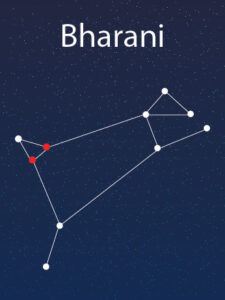
This chart has afflicted jala tattva, with Ātmakāraka Venus involved in a terrible curse of the spouse in the fifth house of love and affection, conjunct Mars and Rāhu. Moon is in Bharaṇī nakṣatra eclipsed by Ketu and aspected by Mars, Rāhu and Saturn. Moreover, both these jala tattva planets are a part of the Kāla Sarpa Yoga. A remedial measure for Venus was suggested to him but he was reluctant to do it. Vāyu tattva is strong in this native, with lagna lord Mercury forming a beautiful Bhadra Mahāpuruṣa Yoga in the fourth house. Mercury has digbala in the ārūḍha lagna, so he was prescribed a very high and spiritual śakti worship of Mercury. There were many obstacles in his receiving the mantra and the remedy instructions and although a spiritual person used to doing various spiritual practices, he could not really tune in with this. Once he started, in however imperfect form, he got immediate results by obtaining an impossible loan to buy a beautiful house ensconced in a lovely garden (Virgo). Hence, Vāyu tattva was activated for remedy to temper the mischief of Rāhu and the nodes in his chart. It is an important reminder that Mercury and Rāhu are posited opposite each other in the Kālacakra, and it is only Mercury who can crush Rāhu.
Astras in Akṣaras
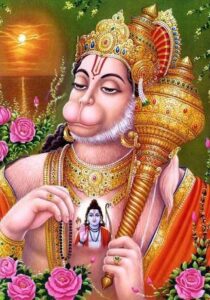
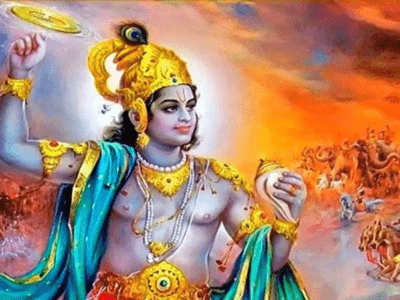

An important facet of prescribing mantras is choosing the best mantra for the deity based on the weapon the deity likes to wield. Chakra as weapons are used for all activities, the lotus for śānti karma, bhūśuṇḍi for māraṇa, daṇḍa for ṅvidveṣaṇa, kartari for breaking others mantras, sūcī for separations, kuliśa for madness, nārāca for breaking into the enemy’s army, śṛṅkhal for and so on. For example, all dvādaśākṣarī mantras have the chakra as the weapon. Hence, the best dvādaśākṣarī mantras are that of Viṣṇu, as Viṣṇu holds the chakra and raises the Sudarśana to protect the native. The Sudarśana is the 12-spoked wheel of the Bhā Chakra. Fifteen akṣara mantras have the bhūśuṇḍi as the astra, and the most powerful of them all is the one for Kālī. She, who will wield the bhūśuṇḍi to destroy the Mithuna bhāva, which is sexuality and hence perfect celibacy is required for māraṇa tantra. One of the perfect celibates was Hanumān, who as an avatar of Rudra, deployed vāyu tattva to set Lankā in flames. Although Hanumān holds the gadā or the mace in his hands, the 15-akṣara mantras of Hanuman have the hidden power of the bhūśuṇḍi behind the gadā. In effect, his gadā ‘acts’ like a bhūśuṇḍi rather than a gadā. Sixteen akṣara mantras have the lotus as the weapon. The lotus symbolises the hṛdpadma, or the heart lotus, the abode of the Inner Self, the sanctum sanctorum of the Paramhaṁsa. The best 16-akṣara mantra is that of Śrī, the undisputable ṣoḍaśī mantra, for it is only with the 16-akṣara mantra that the lotus blooms in the hṛdaya padma, so that the dirt of evil blocking the iṣṭa in the heart will be removed. Other weapons for mantras are in the table below:
Astras help in the determination of the best mantras. Since dvādaśākṣarī mantras hold chakras as their weapons, the best dvādaśākṣarī mantras are Viṣṇu mantras. We therefore recommend 12 akṣara Viṣṇu mantras as iṣṭa devatā mantras. In the example given below, Mercury is the iṣṭa devatā, so one has to decipher a 12 akṣara mantra for Viṣṇu, in this case, the form of Viṣṇu is Ugra Madhusūdana and the mantra is oṁ namo bhagavate vāsudevāya. For in the Bhagavad Gītā Kṛṣṇa says, “In whatever form you shall worship me, in that form I will come to you.” One can choose any form of mantra for the Dharma Devatā, depending on the ayana or dhāma of the native and it need not be Viṣṇu mantras exclusively.
Table 7: Weapons of Mantras
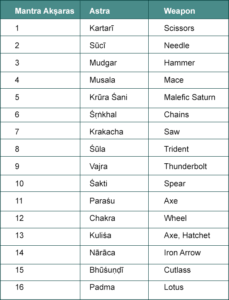
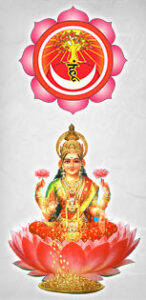
The fourth house is the heart lotus or the hṛdaya padma. The fourth from the Kārakāṁśa is the Mātṛ Bhāva, and is ideal for choosing the highest śakti form. The highest form of śakti is Śrī bearing the lotus, which is the ultimate aim of all mantras. Sātvik forms will have the lotus holding mother in the background, as the most important and the only reality is the lotus. Everything else other than the lotus is an illusion. The Goddess or the Divine Mother, in her compassion, allows us to see whatever form we wish to see her. With the ṣoḍaśakṣarī mantra, She lifts the lotus. The secret of the ṣoḍaśī vidyā is Brahma rakṣā, and when this is disturbed, one’s gati or direction in life is spoiled.
Example
Chart 3: Dvādaśākṣarī Mantra


Mercury is the planet representing the iṣṭa devatā, being 12th from the Kārakāṁśa. The best iṣṭa devatā mantra is a Viṣṇu or a Viṣṇu avatāra mantra, for which one always opts for a dvādaśākṣarī mantra, as the 12th house is the house of mokṣa wherein lies the paramam padam of Viṣṇu. The Uḍḍīśa reveals that it is also because the astra for 12 akṣara mantras is the chakra, the weapon held by Viṣṇu to protect the native. The deity of Viṣṇu represented by Mercury is Ugra Madhusūdana and the mantra for it is Om Namo Bhagavate Vāsudevāya.
Chart 4: Dharma Devatā


Dharma Devatā deities need not be Viṣṇu mantras. In the above example, Jupiter is the planet placed in the ninth house from Kārakāṁśa, making it the planet representing the dharma devatā. Jupiter in general represents divinity in a horoscope[13], and specifically depicts a superior form of the deity, in this case, MahāViṣṇu or Sadāśiva, the ākāśa tattva manifestation of the Supreme Being. In this example, Jupiter is in Pisces, a jala tattva sign, particularly representing the ocean. Therefore, the form of Viṣṇu should be a higher, ākāśa form associated with a water body or a ocean. The chosen deity for the native is Jagannāth, the nirguṇa form of Nārāyaṇa Viṣṇu, situated on the shores of Bay of the Bengal in the eastern coast of India. Since the deity chosen is that of Viṣṇu, a 12-akṣara mantra of Jagannāth was given to the native, which worked wonders for the native. The reason for opting for a Viṣṇu mantra for the native is strengthened by the yoga of Moon-Mercury in the rāśi chart; Moon is the fifth lord exalted and conjunct Mercury, the Ātmakāraka.
[1] Paper presented in the SJC West Coast Conference, 2005, Sunnyvale, USA.
[2] Kurma avatära.
[3] Samudra manthan
[4] Kñirasamudra
[5] For more mantras of Garuòa, see the Garuòa Puräëa.
[6] Hence, one of Çiva’s names is Nélakaëöha or the Blue-throated One.
[7] The literal meaning of chhanda is rhythm.
[8] The conference is taking place while Jupiter is transiting Virgo, the sixth house of the Kälapuruña. This paper is therefore focussing on the ñaökarma or the six types of remedial measures with respect to mantras.
[9] Käma (desire), Krodha (anger), Lobha (greed), Moha (illusion), Mada (arrogance) and Mätsarya (envy).
[10] The time is calculated from local sunrise. Default sunrise time of 6 a.m. is used here.
[11] The bhoga offered is called naivedya.
[12] Gandha means smell or perfumed products like sandalwood paste, camphor, aguru that are ritually used in a Hindu worship.
[13] Praçna Märga
![]()

0 comments